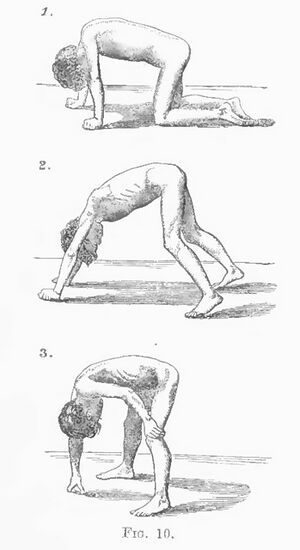◔
Proximal Weakness: Difference between revisions
From WikiMSK
No edit summary |
No edit summary |
||
| Line 10: | Line 10: | ||
{{family tree | | D01 | | D02 | | | | D03 | | |D01=<ul><li>[[Myositis|Inflammatory myositis]]<ul><li>Polymyositis</li><li>dermatomyositis</li><li>immune mediated necrotising myopathy </li></ul></li><li>Endocrine - e.g cushings, dysthyroid</li>Drugs<li>Hyper/hypokalaemia</li></ul>|D02=<ul><li>Becker's or Duchenne's muscular dystrophy</li><li>Limb girdle muscle dystrophies</li><li>Congenital myopathies </li><li>Mitochondrial</li><li>Metabolic ([[Glycogen Storage Diseases|glycogen or lipid disorder]])</li><li>[[Pompe Disease|Acid maltase]]</li></ul>|D03=<ul><li>Peripheral neuropathies with proximal weakness - vasculitis or [[Chronic Inflammatory Demyelinating Polyneuropathy|CIDP]]</li><li>Plexopathies e.g. [[Diabetic Amyotrophy|diabetic amyotrophy]]</li><li>Infiltration nerve root - neoplastic meningitis</li><li>[[Cervical Myelopathy|Myelopathy]]</li><li>Neuromuscular junction - Lambert Eaton myaesthenic syndrome</li><li>Anterior horn cell - spinal muscular atrophies if chronic, motor neuron disease if subacute and progressive}} | {{family tree | | D01 | | D02 | | | | D03 | | |D01=<ul><li>[[Myositis|Inflammatory myositis]]<ul><li>Polymyositis</li><li>dermatomyositis</li><li>immune mediated necrotising myopathy </li></ul></li><li>Endocrine - e.g cushings, dysthyroid</li>Drugs<li>Hyper/hypokalaemia</li></ul>|D02=<ul><li>Becker's or Duchenne's muscular dystrophy</li><li>Limb girdle muscle dystrophies</li><li>Congenital myopathies </li><li>Mitochondrial</li><li>Metabolic ([[Glycogen Storage Diseases|glycogen or lipid disorder]])</li><li>[[Pompe Disease|Acid maltase]]</li></ul>|D03=<ul><li>Peripheral neuropathies with proximal weakness - vasculitis or [[Chronic Inflammatory Demyelinating Polyneuropathy|CIDP]]</li><li>Plexopathies e.g. [[Diabetic Amyotrophy|diabetic amyotrophy]]</li><li>Infiltration nerve root - neoplastic meningitis</li><li>[[Cervical Myelopathy|Myelopathy]]</li><li>Neuromuscular junction - Lambert Eaton myaesthenic syndrome</li><li>Anterior horn cell - spinal muscular atrophies if chronic, motor neuron disease if subacute and progressive}} | ||
{{family tree/end}} | {{family tree/end}} | ||
==Examination== | |||
[[File:Gowers sign.jpg|thumb|right|Gower's sign.<ref name=":0" />]] | |||
Gower's sign is a physical finding used to assess for proximal lower limb muscle weakness particularly in those with certain [[Neuromuscular Disorders Overview|neuromuscular disorders]].<ref name=":0">Gowers. Pseudo-hypertrophic muscular paralysis : a clinical lecture. 1879. From https://archive.org/details/b21517034/page/n13/mode/2up</ref> | |||
To perform the Gower's sign test, the patient is asked to rise from a sitting or lying position on the floor without using their hands or arms for support. Patients with normal muscle strength are able to perform this task with ease. However, patients with proximal lower limb muscle may use their hands and arms to "climb up" their own body, pushing against their thighs, hips, and abdomen to achieve a standing position. This maneuver is often accompanied by compensatory movements, such as hyperextension of the knees or lordosis of the lumbar spine. | |||
==References== | |||
[[Category:Presenting Complaints]] | [[Category:Presenting Complaints]] | ||
[[Category:Neurology]] | [[Category:Neurology]] | ||
[[Category:Neuromuscular Disorders]] | [[Category:Neuromuscular Disorders]] | ||
<references /> | |||
Revision as of 06:08, 10 March 2023
This article is a stub.
Classification
| Proximal Weakness | |||||||||||||||||||||||||||||||||
| Myopathic | Non-Myopathic | ||||||||||||||||||||||||||||||||
| Acquired | Genetic | ||||||||||||||||||||||||||||||||
|
|
| |||||||||||||||||||||||||||||||
Examination

Gower's sign.[1]
Gower's sign is a physical finding used to assess for proximal lower limb muscle weakness particularly in those with certain neuromuscular disorders.[1]
To perform the Gower's sign test, the patient is asked to rise from a sitting or lying position on the floor without using their hands or arms for support. Patients with normal muscle strength are able to perform this task with ease. However, patients with proximal lower limb muscle may use their hands and arms to "climb up" their own body, pushing against their thighs, hips, and abdomen to achieve a standing position. This maneuver is often accompanied by compensatory movements, such as hyperextension of the knees or lordosis of the lumbar spine.
References
- ↑ 1.0 1.1 Gowers. Pseudo-hypertrophic muscular paralysis : a clinical lecture. 1879. From https://archive.org/details/b21517034/page/n13/mode/2up

